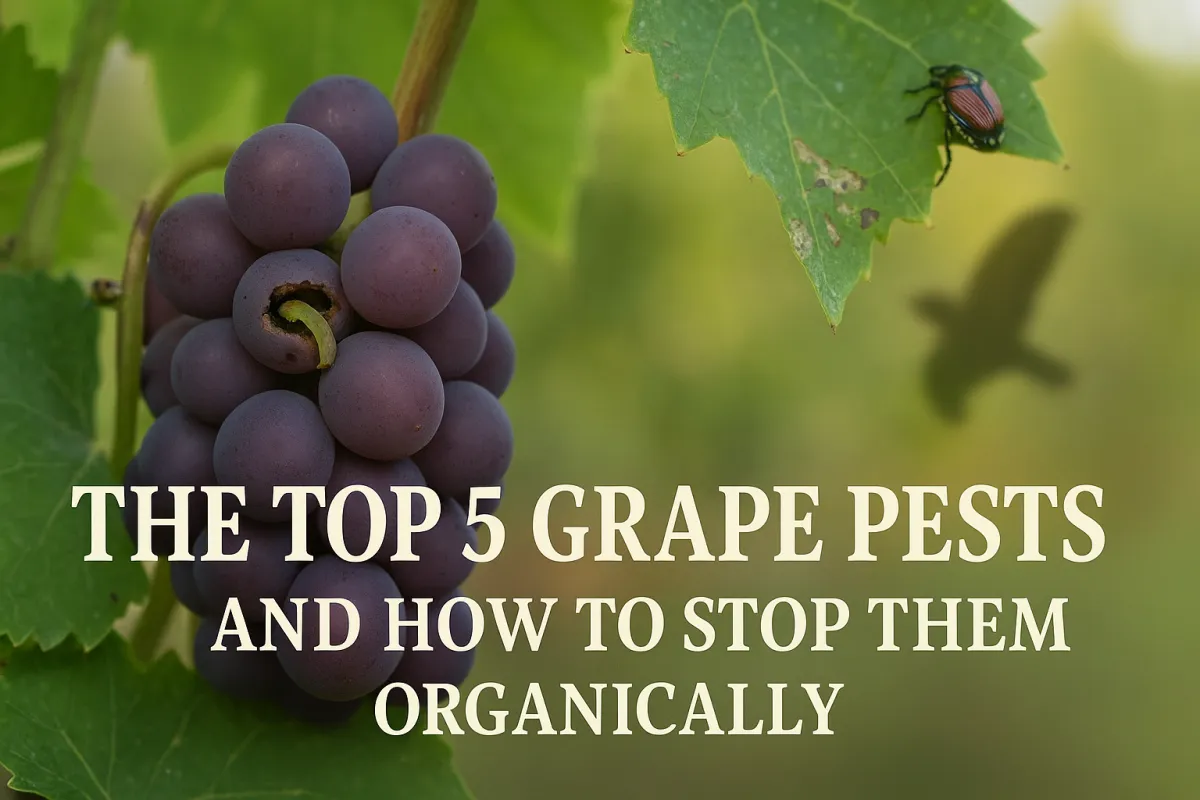
The Top 5 Grape Pests (and How to Control Them Naturally)
The Top 5 Grape Pests (and How to Stop Them Organically)
The Year the Grapes Almost Didn’t Make It
I’ll never forget the summer I thought I was about to harvest my first real grape crop. The vines were loaded, the clusters were just starting to blush — and then I noticed webbing and tiny brown berries on the ground. By the next week, half the cluster was gone. Grape berry moths had found me.
If you grow grapes, you know the feeling — that sinking stomach when pests hit right before harvest. Grapes are some of the most rewarding fruit to grow, but they are also a magnet for pests. The good news? You can protect your vines without resorting to harsh chemicals. Here’s how I keep my grapes healthy and my harvest safe.
Why Grapes Attract Trouble
Grapes are sugar-rich, thin-skinned, and irresistible to everything from insects to deer. They’re also perennial, which means pests quickly learn where to come back year after year.
Zone Note: If you’re in USDA Zone 5–8 like me, you’ll face berry moths, leafhoppers, and Japanese beetles in summer, followed by birds and deer right as the fruit ripens. Southern growers may deal with even more moth generations per season.
1. Grape Berry Moth
How to Spot It
Tiny entry holes on berries
Webbing inside clusters
Premature fruit drop
How to Stop It Organically
Set pheromone traps early. Place them at bloom to monitor moth activity.
Track timing. When moth counts spike, time your treatment window.
Spray organically. Use Bacillus thuringiensis (Bt) or spinosad when egg hatch begins.
Re-check every 10–14 days. Repeat spray if a new flight occurs.
Pro Tip: Use growing degree days (GDD) if your state publishes them. If not, set a simple calendar reminder when bloom starts — timing is everything with this pest.
2. Leafhoppers
How to Spot Them
Tiny white or yellow bugs on underside of leaves
Speckled or stippled leaf damage
Leaves may curl or yellow with heavy infestations
How to Stop Them Organically
Spray insecticidal soap or neem oil when populations are high.
Encourage beneficial predators like lacewings and lady beetles.
Keep vines pruned for good airflow — leafhoppers thrive in dense, humid canopies.
3. Japanese Beetles
How to Spot Them
Metallic green beetles eating leaves from the top down
Skeletonized leaves that look lace-like
How to Stop Them Organically
Morning hand-picking: Beetles are sluggish early; drop them in a bucket of soapy water.
Physical barriers: Row covers or exclusion netting during peak flight can protect leaves.
Avoid pheromone traps near vines: They attract more beetles than they catch.
Grandma’s Tip: “Go beetle-picking before your coffee — they’re slow and easy to catch before the sun warms them up.”
4. Birds
How to Spot Them
Pecked berries or missing clusters just as fruit begins to turn color
How to Stop Them Organically
Netting: Cover the entire vine before berries turn purple.
Visual deterrents: Reflective tape, scare balloons, or fake owls work if moved weekly.
Sound deterrents: Wind chimes or motion-activated devices can add pressure.
5. Deer
How to Spot Them
Cleanly bitten shoots, missing leaves, stripped clusters
Hoof prints or droppings near vines
How to Stop Them Organically
Fencing: 8-foot woven wire is the gold standard.
Rotating repellents: Egg-based sprays, garlic clips, or predator urine work best when rotated.
Motion-activated sprinklers: Great for smaller vineyards or backyard vines.
Printable Grape Pest Quick Sheet
I’ve put together a one-page printable guide with photos of each pest, damage symptoms, and best organic control methods. Print it and keep it in your garden shed for fast reference.
Faith for the Vineyard
Jesus said, “I am the vine, you are the branches. He who abides in Me, and I in him, bears much fruit” (John 15:5). Just like our grapevines, our faith needs constant tending. Ignore it too long and the pests creep in — worry, distraction, and neglect. But with watchfulness and care, the harvest is worth it.
Don’t Let Pests Steal Your Harvest
Pests are a fact of life, but they don’t have to cost you your crop. With a little consistency — and the right tools — you can stay ahead of them.
📌 Next Step: Set a reminder today to check your vines weekly starting at bloom. That one habit will catch most problems before they get out of hand.
📄 Download: Grab the free Grape Pest Quick Sheet to print and hang in your shed so you never have to wonder what you’re looking at.


Facebook
Instagram
X
Youtube